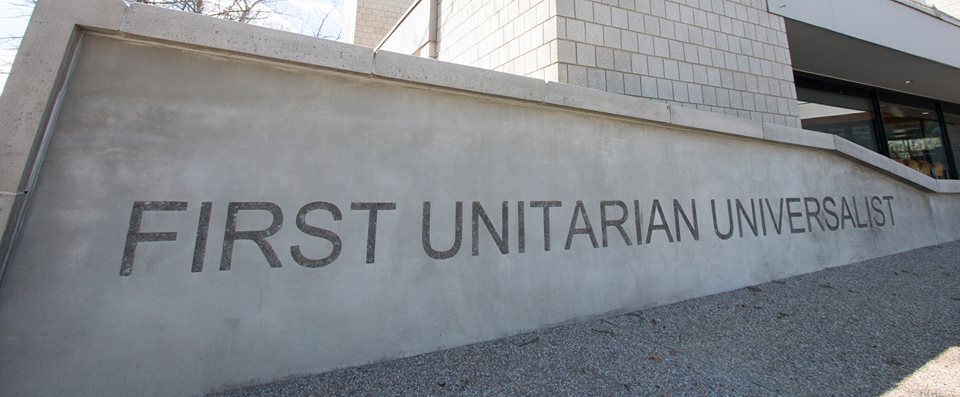About

Welcome to First UU RVA
We’re located in Richmond, Virginia on the edge of the Carillon neighborhood. We are an open, welcoming informed, collaborative interfaith congregation involved in social justice. The church building itself is an example of brutalist architecture.
Membership
Getting to know the church and want to become more involved? Wondering what it means to be a member? We invite you to attend our “Pathway” sessions. Please email membership@richmonduu.org if you are interested. Want to get involved in First U.U? Come to a Pathways session. We’ll make it easy.
History of First UU RVA
THE ROOTS of liberal religion in Richmond, Virginia began early in the 19th Century when missionary circuit riders drifted in from the northeastern states spreading a new religious message. In 1830 Rev. John B. Dods spent six months in the city, organizing the first joint denomination of Unitarians and Universalists. In1831, their new meeting house was dedicated as the First Independent Christian Church of Richmond and John B Pitkin was the first minister to be installed by representatives from both faiths. The unconventional views of Christianity espoused by Rev. Pitkin attracted Richmond’s young intellectuals and businessmen.
Over the next 30 years the church struggled with the ever present financial problems, a succession of transient ministers and the conflict of how to justify their position as a Christian Church. In 1862 the society’s minister, Rev. Alden Bosserman, was arrested in a “sweep” by Richmond’s Confederate Administration along with several well known Unionist Richmond merchants. They were suspected to be operating a ‘Union Underground’ designed to move Union soldiers caught behind the lines back into the North and assist occasional slave runaways. Bosserman, along with Franklin Stearns, Burnham Wardwell, G. W. Frosst and Charles Palmer, was lodged in a slave jail designated for political prisoners awaiting their court hearing; former U.S. Senator, John Minor Botts, spent two months on the second floor of Lumpkin’s slave jail with a view of Shockoe Bottom’s factories through its barred windows. The Richmond Dispatch (04/03/1862) lists Rev. Bosserman among Castle Godwin’s prisoners. His congregation, suspected to be an abolitionist front, continued to live with the indignity of the smear tactics aroused by their leader’s arrest for treason and a hostile community that took advantage of any opportunity to misrepresent their beliefs. After five months in prison, living under deplorable wartime conditions, Rev. Bosserman was released as part of a prisoner exchange.
Virginia’s secession from the Union proved to be the death-knell for the church on Mayo Street. As the war continued, the exceptional prosperity of the city disappeared under the strain of the political situation. Slave discontent turned into rebellion, an embargo had closed the city’s port, businesses began to fail and banks suspended specie payment. The weather was bitterly cold, cholera was rampant and there were food riots. Without leadership or the means to meet their financial obligations, the church disbanded officially in 1875.
RE-ESTABLISHMENT began with Sunday night meetings in the home of D.R. Wilson. At first, it was just a few friends getting together to read liberal literature and share their religious ideas. As more people joined the group, the American Unitarian Association (A.U.A.) initiated a mission effort. Early in 1893 Rev. George L. Chaney came to Richmond and began holding services in Belvidere Hall. A Women’s Alliance and a Sunday school were organized and the congregation grew under Rev. Chaney’s leadership. On December 31, 1893 eighteen people stepped forward to sign the Bond of Union that would formally create the First Unitarian Church of Richmond.
The first years of the new century were hard ones. Mission ministers attempted to hold the congregation together. They met in rented halls and experienced the usual financial problems of a mission church. All this changed in 1904, when the A.U.A. sent a new minister. The Rev. John Robinson used his skills as an organizer to create financial solvency and turn the congregation into a viable presence in the city.
Building History on Blanton Avenue
The First Unitarian Church of Richmond that occupied a full city block facing Byrd Park, between Douglasdale and Garrett Streets, was the New York-based architect Ulrich Franzen’s first church; its ‘brutalist’ design was chosen deliberately to make it look different that other Richmond’s churches (not brick-no steeple). The building received recognition of the Richmond Urban Design Award in 1974 and The Test of Time Award in 2019.
Buildings say things. They present a message even as they merely stand exposed to public view. There are some that stand in the shadow of others. Franzen said, “It will not be just another imposing edifice, not just a church with a steeple.” He called it “a house of life.”
The First Unitarian Church of Richmond opened its doors in September of 1972; and the first worship services were held at 1000 Blanton Avenue on September 24, 1972.The building also has a library, a lobby, several conference rooms, and a nursery for kids–among its other interior spaces.
In 2014, a major in-house renovation was completed, providing a more efficient use of its 18,000 sq. ft. of floor space.
